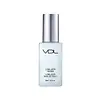What's inside
What's inside
 Key Ingredients
Key Ingredients

 Benefits
Benefits

 Concerns
Concerns

 Ingredients Side-by-side
Ingredients Side-by-side

Cyclopentasiloxane
EmollientWater
Skin ConditioningPropylene Glycol
HumectantDimethicone Crosspolymer
Emulsion StabilisingCyclohexasiloxane
EmollientDimethicone/Vinyl Dimethicone Crosspolymer
Skin ConditioningIsododecane
EmollientSilica
AbrasiveVinyl Dimethicone/Methicone Silsesquioxane Crosspolymer
Sodium Chloride
MaskingCetyl PEG/PPG-10/1 Dimethicone
EmulsifyingDimethicone
EmollientDisteardimonium Hectorite
StabilisingPolyacrylamide
C30-45 Olefin
Skin ConditioningC13-14 Isoparaffin
EmollientC30-45 Alkyl Dimethicone
Skin ConditioningParfum
MaskingHydrogenated Polyisobutene
EmollientIsononyl Isononanoate
EmollientPropylene Carbonate
SolventTitanium Dioxide
Cosmetic ColorantIsopentyldiol
HumectantButylene Glycol
HumectantStearoxytrimethylsilane
EmollientLaureth-7
Emulsifying1,2-Hexanediol
Skin ConditioningTrifolium Pratense Flower Extract
AstringentRosmarinus Officinalis Extract
AntimicrobialCamellia Sinensis Leaf Extract
AntimicrobialSodium Hyaluronate
HumectantCyclopentasiloxane, Water, Propylene Glycol, Dimethicone Crosspolymer, Cyclohexasiloxane, Dimethicone/Vinyl Dimethicone Crosspolymer, Isododecane, Silica, Vinyl Dimethicone/Methicone Silsesquioxane Crosspolymer, Sodium Chloride, Cetyl PEG/PPG-10/1 Dimethicone, Dimethicone, Disteardimonium Hectorite, Polyacrylamide, C30-45 Olefin, C13-14 Isoparaffin, C30-45 Alkyl Dimethicone, Parfum, Hydrogenated Polyisobutene, Isononyl Isononanoate, Propylene Carbonate, Titanium Dioxide, Isopentyldiol, Butylene Glycol, Stearoxytrimethylsilane, Laureth-7, 1,2-Hexanediol, Trifolium Pratense Flower Extract, Rosmarinus Officinalis Extract, Camellia Sinensis Leaf Extract, Sodium Hyaluronate
Water
Skin ConditioningCyclopentasiloxane
EmollientCyclohexasiloxane
EmollientNeopentyl Glycol Diethylhexanoate
EmollientButylene Glycol
HumectantPEG-10 Dimethicone
Skin ConditioningSynthetic Fluorphlogopite
Glycerin
HumectantDipropylene Glycol
HumectantCI 77891
Cosmetic ColorantMagnesium Sulfate
Dimethicone Crosspolymer
Emulsion StabilisingSorbitan Sesquiisostearate
EmulsifyingPanthenol
Skin ConditioningDisteardimonium Hectorite
StabilisingPhenoxyethanol
Preservative1,2-Hexanediol
Skin ConditioningDistearyldimonium Chloride
Tocopheryl Acetate
AntioxidantStearic Acid
CleansingTin Oxide
AbrasiveAlpha-Isomethyl Ionone
PerfumingBenzyl Benzoate
AntimicrobialCitronellol
PerfumingLimonene
PerfumingHexyl Cinnamal
PerfumingLinalool
PerfumingHydroxyisohexyl 3-Cyclohexene Carboxaldehyde
MaskingButylphenyl Methylpropional
PerfumingParfum
MaskingWater, Cyclopentasiloxane, Cyclohexasiloxane, Neopentyl Glycol Diethylhexanoate, Butylene Glycol, PEG-10 Dimethicone, Synthetic Fluorphlogopite, Glycerin, Dipropylene Glycol, CI 77891, Magnesium Sulfate, Dimethicone Crosspolymer, Sorbitan Sesquiisostearate, Panthenol, Disteardimonium Hectorite, Phenoxyethanol, 1,2-Hexanediol, Distearyldimonium Chloride, Tocopheryl Acetate, Stearic Acid, Tin Oxide, Alpha-Isomethyl Ionone, Benzyl Benzoate, Citronellol, Limonene, Hexyl Cinnamal, Linalool, Hydroxyisohexyl 3-Cyclohexene Carboxaldehyde, Butylphenyl Methylpropional, Parfum
Ingredients Explained
These ingredients are found in both products.
Ingredients higher up in an ingredient list are typically present in a larger amount.
1,2-Hexanediol is a synthetic liquid and another multi-functional powerhouse.
It is a:
- Humectant, drawing moisture into the skin
- Emollient, helping to soften skin
- Solvent, dispersing and stabilizing formulas
- Preservative booster, enhancing the antimicrobial activity of other preservatives
Butylene Glycol (or BG) is used within cosmetic products for a few different reasons:
Overall, Butylene Glycol is a safe and well-rounded ingredient that works well with other ingredients.
Though this ingredient works well with most skin types, some people with sensitive skin may experience a reaction such as allergic rashes, closed comedones, or itchiness.
Learn more about Butylene GlycolCyclohexasiloxane is a type of silicone more commonly known as D6. It is an emollient and solvent.
Cyclohexasiloxane is used to evenly distribute ingredients throughout the product. When applied to the skin, Cyclohexasiloxane evaporates and leaves behind a silky feel.
As an emollient, it can help the skin feel soft and hydrated. It is also used to reduce frizz in hair products.
Learn more about CyclohexasiloxaneCyclopentasiloxane, or D5, is a silicone used to improve texture of products and trap moisture.
D5 is considered lightweight and volatile. Volatile means it evaporates quickly after application. Once evaporated, D5 leaves a thin barrier that helps keep skin hydrated.
It is also an emollient. Emollients help soften the skin and prevent water loss. Silicones create a silky texture in products. D5 helps other ingredients become more spreadable.
Studies show D5 is safe to use in skincare products. We recommend speaking with a skincare professional if you have concerns.
Learn more about CyclopentasiloxaneDimethicone Crosspolymer is a silicone created by modifying dimethicone with hydrocarbon side chains. Due to its large size, it does not penetrate skin. It is considered non-occlusive.
Dimethicone Crosspolymer is used to stabilize and thicken products. It also helps give products a silky feel.
Disteardimonium Hectorite comes from the clay mineral named hectorite. It is used to add thickness to a product.
It can also help stabilize a product by helping to disperse other ingredients.
Hectorite is a rare, white clay mineral.
Learn more about Disteardimonium HectoriteParfum is a catch-all term for an ingredient or more that is used to give a scent to products.
Also called "fragrance", this ingredient can be a blend of hundreds of chemicals or plant oils. This means every product with "fragrance" or "parfum" in the ingredients list is a different mixture.
For instance, Habanolide is a proprietary trade name for a specific aroma chemical. When used as a fragrance ingredient in cosmetics, most aroma chemicals fall under the broad labeling category of “FRAGRANCE” or “PARFUM” according to EU and US regulations.
The term 'parfum' or 'fragrance' is not regulated in many countries. In many cases, it is up to the brand to define this term.
For instance, many brands choose to label themselves as "fragrance-free" because they are not using synthetic fragrances. However, their products may still contain ingredients such as essential oils that are considered a fragrance by INCI standards.
One example is Calendula flower extract. Calendula is an essential oil that still imparts a scent or 'fragrance'.
Depending on the blend, the ingredients in the mixture can cause allergies and sensitivities on the skin. Some ingredients that are known EU allergens include linalool and citronellol.
Parfum can also be used to mask or cover an unpleasant scent.
The bottom line is: not all fragrances/parfum/ingredients are created equally. If you are worried about fragrances, we recommend taking a closer look at an ingredient. And of course, we always recommend speaking with a professional.
Learn more about ParfumWater. It's the most common cosmetic ingredient of all. You'll usually see it at the top of ingredient lists, meaning that it makes up the largest part of the product.
So why is it so popular? Water most often acts as a solvent - this means that it helps dissolve other ingredients into the formulation.
You'll also recognize water as that liquid we all need to stay alive. If you see this, drink a glass of water. Stay hydrated!
Learn more about Water